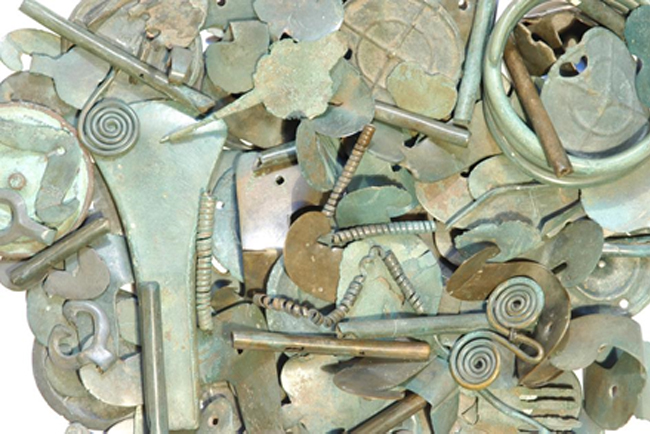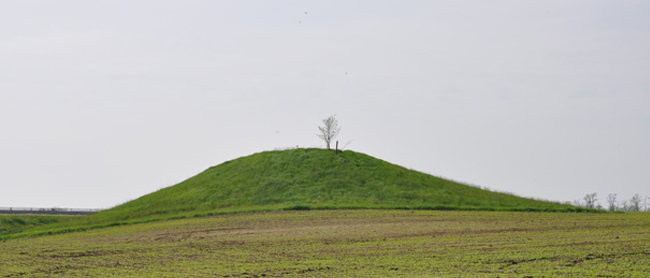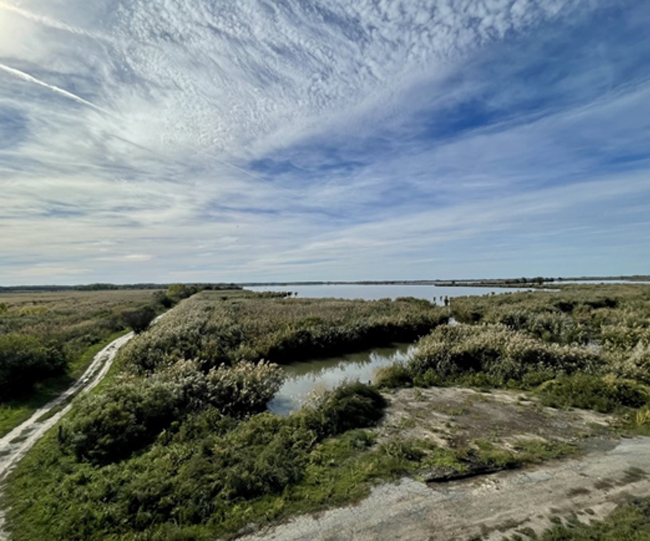Az idei évben Rómában, hibrid formában kerül megrendezésre az Európai Régészek Szövetsége (EAA) 30. éves konferenciája augusztus 28 és 31. között. A hét témakörben a tudományos szekciók bőséges választéka került meghirdetésre.
Előadással 2024. február 8-ig, poszterrel 2024. április 8-ig lehet jelentkezni a konferenciára. Az egyes szekciók megvalósulásához legalább hat előadás szükséges, ezért bíztatunk mindenkit a jelentkezésre és az absztraktok feltöltésére.
A P. Fischl Klára és munkatársai által benyújtott #432. szekció az őskori épületek és települések építészeti megoldásaival (helyválasztás, építőanyagok, azok természettudományos vizsgálata, használt technológiák) és alaprajzi sémáinak rekonstrukciós lehetőségeivel foglalkozik a feltárt épületnyomok vizsgálatával és az etnoarcheologiai párhuzamok a bevonásával.

Borsodivánka-Marhajárás-Nagyhalom, a középső bronzkori G ház plasztikus dísze (Fotó: Baranczó Benedek)
Session: #432
Residential Building Techniques with Wood and Daub in Prehistory: What We Find and What We Reconstruct
Main organiser:
Klara Pusztaine Fischl (HUN-REN Research Centre for the Humanities Institute of Archaeology)
Co-organisers:
Tobias Kienlin (Universität zu Köln Institut für Ur- und Frühgeschichte)
Marian Lie (Institute of Archaeology Iași, Romanian Academy)
Jana Anvari (Universität zu Köln Institut für Ur- und Frühgeschichte)Architecture, or the practice of building houses, encompasses a range of related activities, such as the consensus reached of where and what to build, preparing the building site by felling trees and levelling the ground, supplying construction timber for crafting various parts of the house, excavating foundation trenches or postholes, obtaining and refining clay for the home's walls and other elements. After the structure was completed, it may have required repairs to its walls and roof. The hearths or ovens would have needed periodic renewal in their original position or occasional reposition to another room or location. In temperate European regions during prehistory, wood and daub were primary construction materials. Prehistoric house-building techniques share common aspects with traditional, vernacular architecture, and therefore can enhance our comprehension of prehistoric building techniques and the remains of prehistoric houses and structures unearthed in excavations. The session will focus on the construction techniques and raw materials used for building in prehistoric temperate Europe. The aspects covered will include the evidence we have for the types of wood used, the traces and techniques of woodworking, the choice of raw materials and their preparation for building in daub. While the focus remains on direct evidence recovered during excavations, additional insights from vernacular architecture, ethnoarchaeology or scientific analyses of the building materials retrieved can be gleaned. We welcome a diverse range of contributions spanning from the Neolithic to the Iron Age, encompassing various forms of settlements and architectural styles. These may include, but are not limited to, flatland sites, settlement mounds and wetland sites, with a specific focus on building processes and techniques, as well as materials that were used. We invite contributions that consider relevant features from archaeological excavations, based on the scientific analysis of building remains, as well as a broader perspective including ethnoarchaeological approaches.
A Fülöp Kristóf társszervezésével megvalósuló #627. szekcióban különféle vizsgálati módszerekre és adatokra (régészeti leletanyag és kontextus, kísérleti régészet, makroszkópikus megfigyelések, természettudományos vizsgálatok) támaszkodva a hamvasztásos temetkezések körülményeit, rekonstruálható elemeit és mozzanatait járják körbe a bronzkortól kezdve egészen a római korig bezárólag.

2017. évi hamvasztási kísérlet, edények a máglyán (Fotó: Fülöp Kristóf)
Session: #627
More than Fire: Investigating Pyre Technology in Experimental and Archaeological Cremations for Understanding the Burning Conditions
Main organiser:
Elisavet Stamataki (Vrije Universiteit Brussel)
Co-organisers:
Kristóf Fülöp (HUN-REN Research Centre for the Humanities, Institute of Archaeology)
Giovanni Magno (Morgagni Museum of Human Anatomy - University Museums Centre CAM, University of Padua)
Cremation was the dominant funerary rite in many regions on the European continent from the Late Bronze Age to the Roman period (ca. 1300 BCE-300 AD). As a result, cremated human remains are commonly found in archaeological contexts. The role and the use of fire in funerary archaeology have mostly been linked to the ability of fire to transform the human body into burnt bones and ashes. Beyond its practical purposes, fire in the mortuary context has also been seen as a symbolic means of elaborating or extending the ritual process, enabling a new kind of interaction between the living participants in cremation and the deceased. However, due to the destructive nature of fire and the lack of written sources from the Bronze and Iron Ages, it is extremely difficult to investigate how cremation was performed in past societies. Assessing the variability in cremation conditions over time and space is crucial for understanding the various attitudes of ancient communities towards death and the different methods for managing and treating the deceased. Therefore, it is necessary to turn to other types of evidence to further investigate the burning conditions (e.g., ignition, temperature, fuel, duration, pyre structure, and size, pyre goods, body position, location of the pyre in the environment, extinguishing methods, seasonality, etc.), such as experimental archaeology, archaeological sciences, macroscopic analysis, and ethnographic information.
This session aims to bridge the gap between macroscopic and scientific analysis of burnt human remains and experimental archaeology for understanding pyre technology as well as body and pyre management in ancient societies in which cremation was the main funerary practice. In this session, we welcome presentations from experimental archaeology on pyrotechnology, archaeological sciences, macroscopical analysis, anthracology, and new approach techniques on cremated bones from all chronological periods and without geographical limitation.
Kiss Viktória és munkatársai által szervezett #950. szekció célja, hogy az észak-olaszországi, kelet-alpi, Kárpát-medencei és észak-balkáni régiók különböző régészeti korszakainak fémművességével foglakozó kutatók közös platformjául szolgáljon. Mivel a téma kutatásához komplex módszertanra van szükség, amelyben a hagyományos régészeti módszerek mellett a nyersanyagok kutatása és az írott források vizsgálata is fontos szerepet játszik, a szervezők erősíteni szeretnék a rézbányászat és kereskedelem, a kohászati technológiák, és a fémek eredetével, továbbá a réz- és bronzkereskedelemhez kapcsolódó egyéb nyersanyagok (pl. állati eredetű, textil vagy más szerves maradványok) vizsgálatával foglalkozó szakemberek párbeszédét.

A zalaszabari középső bronzkori kincs tárgyai (Fotó: Tétényi Csaba)
Session #950
Trade in Metals from the Bronze Age till Early Modern Times between the Carpathian Basin and the Northern Adriatic
Main organiser:
Viktória Kiss (Institute of Archaeology, Research Centre for the Humanities, Budapest, Hungary)
Co-organisers:
Beatrix Romhányi (Medieval Studies Department, Károli Gáspár Calvinist University, Hungary)
Claudio Cavazzuti (Prehistory & Protohistory Dept., University of Bologna, Italy)
Ivana Angelini (Department of Cultural Heritage, University of Padua, Italy)
From the beginning of the Copper Age until the pre-modern era, copper played a prominent role in the economy. Mining and trading the metal – be it pure copper or a copper alloy – created corridors of interaction that connected distant regions in Europe and beyond. Previous research has shown that these trade networks existed over the long term, and even when they were temporarily disbanded for various reasons – demographic, environmental or political – they re-emerged as soon as circumstances became favourable. The part of Europe comprising Northern Italy, the Eastern Alps, the Carpathian Basin, and the Northern Balkans was one of the geographical settings where – due to rich natural resources and their long exploitation over millennia – such networks can be traced and studied in a diachronic perspective. The study of such long-term processes requires a complex methodology that includes traditional archaeological methods, material analysis and, in the periods where they exist, the use of written evidence. The aim of the session is to bring together researchers from different archaeological periods who deal with copper-bearing objects, objects related to mining, metallurgical technologies and metal provenance, as well as other artefacts also connected to copper trading (e.g. animals, textile or other organic materials). The focus of the session is on the diachronic consideration of metal production and trade in the respective geographical region, with a special emphasis on the connections between Italy and the Carpathian Basin, in line with the motto of the conference – Persisting with change.
A Kulcsár Gabriella társszervezésével létrejövő #359 szekció célja, hogy áttekintést nyújtson a The Yamnaya Impact on Prehistoric Europe (YMPACT) című ERC program által az elmúlt öt évben végzett kutatásokról, és a téma más kutatóit is bevonva a tudományos diskurzusba, az új adatok fényében megvizsgálja az őskori Európát érő Kr.e. 4-3. évezredi steppei hatásokat, kijelölve a jövő kutatási irányait is. A YMPACT projekt interdiszciplináris megközelítésének megfelelően a szekció szervezői a régészet, a bioantropológia, az archeogenetika, a lipid vizsgálatok és az izotóp-geokémia témakörében is várják az előadásokat.

Session: #359
The 4th and 3rd Millennium BC Steppe Impact on Prehistoric Europe
Main organiser:
Volker Heyd (University of Helsinki)
Co-organisers:
Gabriella Kulcsár (Institute of Archaeology, HUN-REN Research Centre for the Humanities)
János Dani (University of Szeged)
Denis Topal (National Museum of History of Moldova)
Stefano Palalidis (Independent researcher)
In January 2019, the ERC Advanced Project ‘The Yamnaya Impact on Prehistoric Europe (YMPACT)’ embarked on a journey to investigate the massive transformation that swept across Europe approximately 5000 years ago. Hosted by the University of Helsinki, Finland, and with partners working in the UK, Germany, and Hungary, the project has been an international and interdisciplinary team effort focusing on the western end of the huge Yamnaya distribution area, in the steppe landscapes of present-day territories of Romania, Bulgaria, Serbia, and Hungary. Despite the unforeseen obstacles presented by the COVID-19 pandemic and the Russian invasion of the Ukraine, close collaboration with local archaeologists in these countries facilitated intensive fieldwork and sample collection, culminating in three archaeological excavation campaigns, in Boldești-Grădiștea in Romania (2019), Mogila in Bulgaria (2021), and Hajdúböszörmény in Hungary (2023). This session aims to offer a comprehensive overview of research conducted not only by YMPACT in the past five years, but also inviting other scholars to add data enriching our understanding of the Yamnaya impact on prehistoric Europe and opening up lines of future research. Drawing inspiration from the project's collaborative and interdisciplinary approach, the session will host contributions spanning archaeology, bio-anthropology, genetics/ancient DNA, biomarker lipids, and isotope biogeochemistry. Geo- and environmental sciences will contribute to discussions on palaeoclimatology, climate change research, soil formation processes, and landscape reconstructions. Lectures will present latest research, delving into the funerary archaeology of Yamnaya kurgans and material culture; exchange dynamics with southeastern European societies; the physical appearance and population dynamics of the Yamnaya; data on their mobility, diet, occupation, and lifestyle; their intricate connection with the environment; and the profound nature of the wider Yamnaya Impact.
A Zatykó Csilla társzervezésében megvalósuló #1167 szekció a különféle vízparti tájak, ártéri élőhelyek megtelepedésre, települési formákra, anyagi kultúrára, társadalmi és gazdasági struktúrákra gyakorolt hatásait, valamint az emberi közösségeknek a környezet változásaira adott reakcióit vizsgálja meg a római kort megelőző időktől a késő középkorig, regionális és mikroregionális léptékű kutatások bemutatásával.

Session: #1167
Historical Archaeologies of the Coastal and Fluvial Anthroposphere – landscapes and structures, combining settlement archaeology and geosciences
Main organiser:
László Ferenczi (Department of Archaeology, Charles University, Czech Republic)
Co-organisers:
Martina Bergamo (Ca' Foscari University of Venice, Italy)
Jacopo Paiano (Ca' Foscari University of Venice, Italy)
Rowin van Lanen (The Cultural Heritage Agency of the Netherlands, Netherlands)
Csilla Zatykó (HUN-REN, Research Centre for the Humanities, Institute of Archaeology, Hungary)
As highlighted in a recent position paper (Werther-Mehler 2021), fluvial landscapes/floodplain environments are global hotspots, particularly sensitive to socioenvironmental changes. Similarly, littoral landscapes, lagoonscapes, shallow shorelines, extensive coastal marshes, with their constantly changing morphology and different resources, proved to be particularly appealing places for human settlement and represent critical contexts for observing settlement dynamics from a diachronic perspective.
On one hand, material culture perspectives (i.e. building and settlement archaeological observations) demonstrate an interdependence between environment, as environmental variability played a fundamental role in shaping material and social structures (construction techniques, productions, infrastructures, or property systems, labour organization and the size of the respective communities). On the other hand, advances in geoarchaeology, palaeoecology, remote sensing techniques and GIS modelling provide increasingly rich views into the dynamics of these systems, and into a variety of factors (e.g. climate, geology, river morphology) influencing the strategies of human communities. Wetland landscapes constantly attracted human populations, yet their dynamic changes (in terms of population size, social organization, landscape environment) posed considerable challenges, requiring adaptation. Although in historical periods, the multicausal nature of anthropogenic forcing mechanisms is better documented, particularly the changing intensity and scale of settlement (contraction-expansion), fundamentally influencing land-cover changes, and also fluvial responses, large scale patterns are less well understood.
Our session adopts a multiperiod-approach, from pre-Roman to late medieval times, inviting papers that
- provide a regional/sub-regional perspective
- investigate "short" or "long durée" human adaptation strategies in specific landscapes
- contrast environmental “determinism” (constraints) and eco-possibilism (human adaptation)
- demonstrate the combined use of geoscientific and settlement archaeological methods to reconstruct past human activities, environmental change, crisis management-resilience strategies
- study settlement structure/distribution dynamics in relation to environmental/socio-economic factors (relevant from the point of view of wetland management)
- track responses of human communities to environmental change (flooding, erosion, other hazards)


